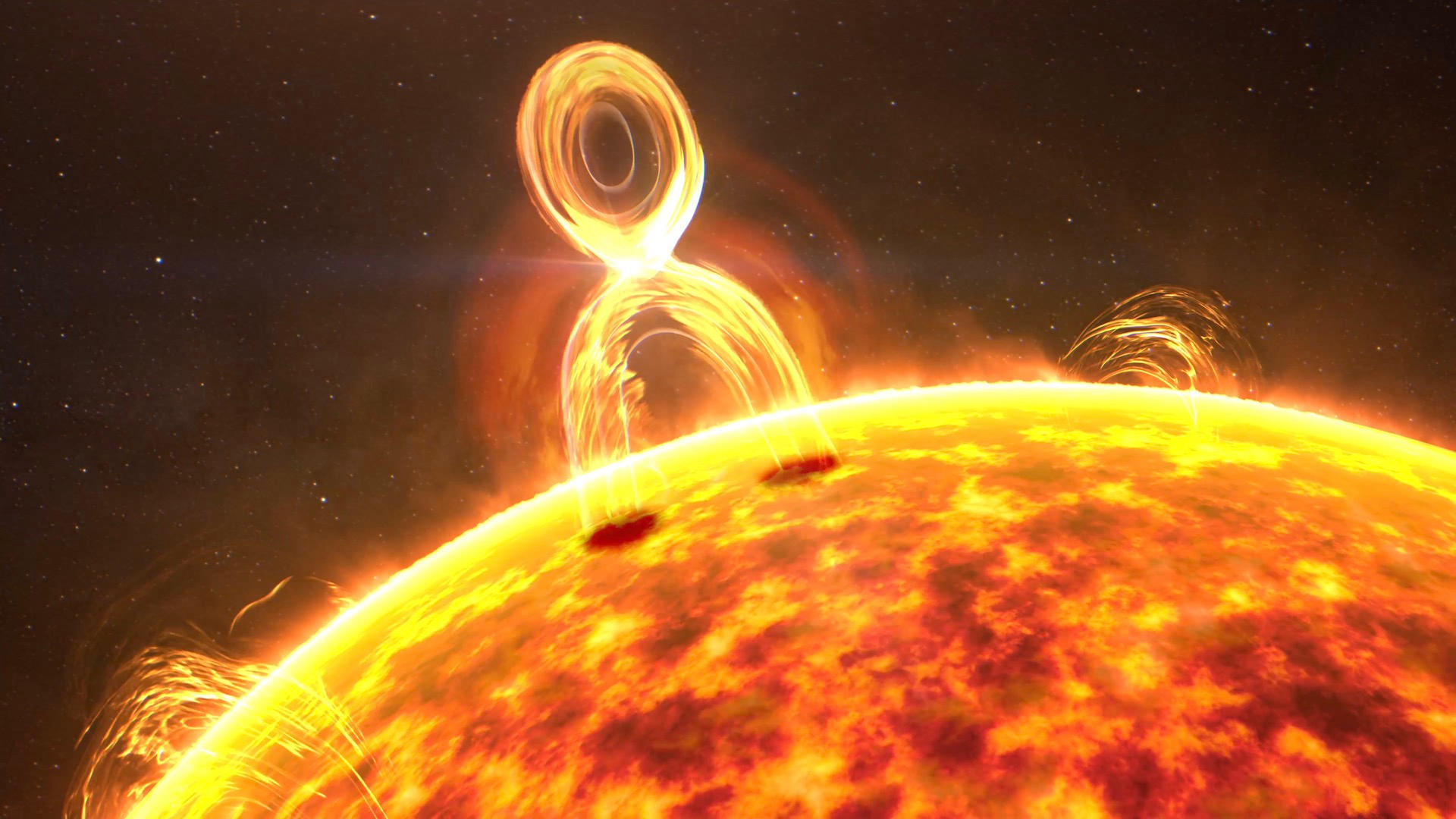Ảnh chụp màn hình từ Phòng thí nghiệm hình ảnh khái niệm của NASA về “Kết nối lại từ tính trên khắp Hệ Mặt trời.” Sự kết nối lại từ tính xảy ra khi các từ trường song song – được tìm thấy trong trường hợp này là các vết lóa mặt trời – va chạm, phá vỡ và sắp xếp lại. Quá trình này tạo ra một vụ nổ năng lượng cao phóng các hạt trong không gian. Tín dụng: Phòng thí nghiệm hình ảnh khái niệm của NASA
Các nhà khoa học sử dụng tia laser cực mạnh để tạo ra các vệt sáng mặt trời thu nhỏ nhằm nghiên cứu quá trình tái kết nối từ trường.
Các nhà khoa học đã sử dụng mười hai chùm tia laze năng lượng cao để mô phỏng các vết lóa mặt trời nhỏ nhằm nghiên cứu các cơ chế cơ bản của sự tái kết nối từ trường, một hiện tượng thiên văn cơ bản.
Trái ngược với niềm tin phổ biến, vũ trụ không trống rỗng. Bất chấp cụm từ “khoảng trống bao la của không gian”, vũ trụ chứa đầy các vật chất khác nhau như hạt tích điện, khí và tia vũ trụ. Trong khi các thiên thể có vẻ hiếm, thì vũ trụ đang nhộn nhịp hoạt động.
Một trong những chuyển động như vậy của các hạt và năng lượng trong không gian là một hiện tượng gọi là kết nối lại từ trường. Đúng như tên gọi, quá trình kết nối lại từ tính diễn ra khi hai từ trường song song—như trong hai từ trường chuyển động ngược chiều nhau—va chạm, phá vỡ và sắp xếp lại. Mặc dù nó có vẻ vô hại, nhưng nó không bình tĩnh.
Hiện tượng này tồn tại ở mọi nơi trong vũ trụ. Ở nhà, bạn có thể nhìn thấy chúng trong các vệt sáng mặt trời hoặc trong từ quyển của Trái đất. Taichi Morita, phó giáo sư tại Đại học Kyushu Khoa Khoa học Kỹ thuật và là tác giả đầu tiên của nghiên cứu. “Trên thực tế, cực quang hình thành là kết quả của các hạt tích điện bị đẩy ra từ sự kết nối lại từ tính trong từ trường của Trái đất.”
Tuy nhiên, mặc dù nó xảy ra phổ biến, nhiều cơ chế đằng sau hiện tượng này vẫn còn là một bí ẩn. Các nghiên cứu đang được tiến hành, chẳng hạn như trong[{” attribute=””>NASA’s Magnetospheric Multiscale Mission, where magnetic reconnections are studied in real-time by satellites sent into Earth’s magnetosphere. However, things such as the speed of reconnection or how energy from the magnetic field is converted and distributed to the particles in the plasma remain unexplained.
An alternative to sending satellites into space is to use lasers and artificially generate plasma arcs that produce magnetic reconnections. However, without suitable laser strength, the generated plasma is too small and unstable to study the phenomena accurately.
“One facility that has the required power is Osaka University’s Institute for Laser Engineering and their Gekko XII laser. It’s a massive 12-beam, high-powered laser that can generate plasma stable enough for us to study,” explains Morita. “Studying astrophysical phenomena using high-energy lasers is called ‘laser astrophysics experiments,’ and it has been a developing methodology in recent years.”
In their experiments, reported in Physical Review E, the high-power lasers were used to generate two plasma fields with anti-parallel magnetic fields. The team then focused a low-energy laser into the center of the plasma where the magnetic fields would meet and where magnetic reconnection would theoretically occur.
“We are essentially recreating the dynamics and conditions of a solar flare. Nonetheless, by analyzing how the light from that low-energy laser scatters, we can measure all sorts of parameters from plasma temperature, velocity, ion valence, current, and plasma flow velocity,” continues Morita.
One of their key findings was recording the appearance and disappearance of electrical currents where the magnetic fields met, indicating magnetic reconnection. Additionally, they were able to collect data on the acceleration and heating of the plasma.
The team plans on continuing their analysis and hopes that these types of ‘laser astrophysics experiments’ will be more readily used as an alternative or complementary way to investigate astrophysical phenomena.
“This method can be used to study all sorts of things like astrophysical shockwaves, cosmic-ray acceleration, and magnetic turbulence. Many of these phenomena can damage and disrupt electrical devices and the human body,” concludes Morita. “So, if we ever want to be a spacefaring race, we must work to understand these common cosmic events.”
Reference: “Detection of current-sheet and bipolar ion flows in a self-generated antiparallel magnetic field of laser-produced plasmas for magnetic reconnection research” by T. Morita, T. Kojima, S. Matsuo, S. Matsukiyo, S. Isayama, R. Yamazaki, S. J. Tanaka, K. Aihara, Y. Sato, J. Shiota, Y. Pan, K. Tomita, T. Takezaki, Y. Kuramitsu, K. Sakai, S. Egashira, H. Ishihara, O. Kuramoto, Y. Matsumoto, K. Maeda and Y. Sakawa, 10 November 2022, Physical Review E.
DOI: 10.1103/PhysRevE.106.055207
The study was funded by the Japan Society for the Promotion of Science.
“Nhà phân tích. Con mọt sách thịt xông khói đáng yêu. Doanh nhân. Nhà văn tận tâm. Ninja rượu từng đoạt giải thưởng. Một độc giả quyến rũ một cách tinh tế.”
